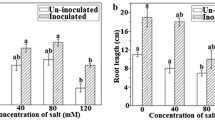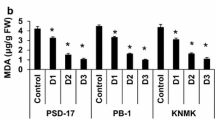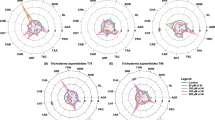Abstract
Ameliorative effects of Trichoderma harzianum (Th-6) on monocot crops under saline environment using hydroponic system were examined. Both rice and maize seeds were coated with T. harzianum (Th-6) and used for the saline and non-saline treatment. Germination and seedling growth performance were studied. T. harzianum (Th-6)-treated seeds showed constantly faster and more uniform germination as compared to untreated seeds. Moreover, seeds treated with Trichoderma improved plants’ growth and physiological performance under hydroponic saline environment compared to control. The treatments showed higher relative water content (RWC), dark-adapted quantum yield (F v/F m ratio), performance index (PIABS), photochemical quenching (q P), stomatal conductance (g s), pigments concentrations and antioxidant enzymes as compared to untreated saline environment. Application of endophyte inhibited the Na+ and Cl− ion uptake in leaves when plants were exposed to saline environment. However, H2O2 contents of both treated crops declined under hydroponic salt stress environment. Physiological mechanism of T. harzianum (Th-6) application in mitigating the salt-related consequences of both monocot crops was discussed.







Similar content being viewed by others
References
Abeer H, Abd-Allah EF, Alqarawi AA, Alwhibi MS, Alenazi MM, Dilfuza E (2015) Arbuscularmycorrhizal fungi mitigates NaCl induced adverse effects on Solanum lycopersicum L. Pak J Bot 47:327–340
Ahmad P, Prasad MNV (2012) Abiotic stress responses in plants metabolism, productivity and sustainability. Springer, New York
Ahmad P, Jaleel CA, Salem MA, Nabi G, Sharma S (2010) Roles of enzymatic and non-enzymatic antioxidants in plants during abiotic stress. Crit Rev Biotechnol 30:161–175
Ahmad P, Ozturk M, Sharma S, Gucel S (2014) Effect of sodium carbonate-induced salinity-alkalinity on some key osmoprotectants, protein profile, antioxidant enzymes, and lipid peroxidation in two mulberry (Morus alba L.) cultivars. J Plant Interact 9:460–467
Ahmad P, Abeer H, Elsayed FAA, Alqarawi AA, Riffat J, Dilfuza E, Salih G (2015) Role of Trichoderma harzianum in mitigating NaCl stress in Indian mustard (Brassica juncea L.) through antioxidative defense system. Front Plant Sci 6:868
Alqarawi AA, Hashem A, Abd Allah EF (2014) Alleviation of salt-induced adverse impact via mycorrhizal fungi in Ephedra aphylla Forssk. J Plant Interact 9:802–810
Azam F, Lodhi A, Farooq S, Harry-Ókuru R, Imam SH (2005) Seed treatment with phytohormones and crop productivity. III. Physiological/biochemical changes in germinating seeds and rooting characteristics of wheat (Triticum aestivum L.) following exposure to 2, 4 D. Pak J Bot 37:865–874
Azooz MM, Youssef AM, Ahmad P (2011) Evaluation of salicylic acid (SA) application on growth, osmotic solutes and antioxidant enzyme activities on broad bean seedlings grown under diluted seawater. Int J Plant Physiol Biochem 3:253–264
Barrs HD, Weatherley PE (1962) A re-examination of the relative turgidity technique for estimating water deficits in leaves. Aust J Biol Sci 15:413–428
Bates L, Waldren PP, Teare JD (1973) Rapid determination of proline for water stress studies. Plant Soil 39:205–207
Benitez T, Rincon AM, Limon MC, Codon AC (2004) Biocontrol mechanisms of Trichoderma strains. Int J Microbiol 7:249–260
Bewley JD, Black M (1985) Seed physiology of development and germination. Plenum Publishing Corporation, New York, p 445
Beyer WF, Fridovich I (1987) Assaying for superoxide dismutase activity: some large consequences of minor changes in condition. Ann Biochem 161:559–566
Bienert GP, Moller AL, Kristiansen KA, Schulz A, Moller IM, Schjoerring JK (2007) Specific aquaporins facilitate the diffusion of hydrogen peroxide across membranes. J Biol Chem 282:1183–1192
Bjorkman T, Harman GE, Price HC (1994) Effects of the biocontrol fungus Trichoderma harzianum on root development in Zea mays. Plant Physiol (Rockville) 105:44
Bjorkman T, Harman GE, Blanchard L (1995) Root development in sweet corn inoculated with the biocontrol fungus Trichoderma harzianum. HortScience 30:810
Borde M, Dudhane M, Jite P (2012) Growth, water use efficiency and antioxidant defense responses of mycorrhizal and non mycorrhizal Allium sativum L. under drought stress condition. Ann Plant Sci 1:6–11
Bradford MM (1976) A rapid and sensitive method for the quantitation of microgram quantities of protein utilizing the principle of protein-dye binding. Ann Biochem 72:248–254
Chi Lin C, Huei Kao C (2001) Relative importance of Na+, Cl, and abscisic acid in NaCl induced inhibition of root growth of rice seedlings. Plant Soil 237:165–171
Colla G, Youssef R, Mariateresa C (2006) Effect of salinity on yield, fruit quality, leaf gas exchange, and mineral composition of grafted watermelon plants. HortScience 41:622–627
Coolbear P, Francis A, Grierson D (1984) The effect of low temperature pre-sowing treatment on the germination performance and membrane integrity of artificially aged tomato seeds. J Exp Bot 35:1609–1617
Dahnke WC, Whitney DA (1988) Measurement of soil salinity. In: Dahnke WC (ed) Recommended chemical soil test procedures for the North Central Region, pp 32–34
Farooq M, Basra SMA, Hafeez K, Ahmad N (2005) Thermal hardening: a new seed vigor enhancement tool in rice. J Integr Plant Biol 47:187–193
Flowers TJ, Gaur PM, Gowda CLL, Krishnamurthy L, Samineni S, Siddique KHM, Turner NC, Vadez V, Varshney RK, Colmer TD (2010) Salt sensitivity in chickpea. Plant Cell Environ 33:490–509
Greenway H, Munns H (1980) Mechanisms of salt tolerance in non halophytes. Annu Rev Plant Physiol 31:49–190
Gusain YS, Singh US, Sharma AK (2014) Enhance activity of stress related enzymes in rice (Oryza sativa L.) induced by plant growth promoting fungi under drought stress. Afr J Agric Res 9:1430–1434
Hameed A, Egamberdieva D, Abd-Allah EF, Hashem A, Kumar A, Ahmad P (2014) Salinity stress and arbuscular mycorrhizal symbiosis in plants. In: Use of microbes for the alleviation of soil stresses, vol 1, pp 139–159
Harman GE, Howell CR, Vitarbo A, Chet I, Lorito M (2004) Trichoderma species—opportunistic, avirulent plant symbionts. Nat Rev Microbiol 2:43–56
Hashem A, Abd-Allah EF, Alqarawi AA, Al-Huqail AA, Egamberdieva D (2014) Alleviation of abiotic salt stress in Ochradenus baccatus (Del.) by Trichoderma hamatum (Bonord.) Bainier. J Plant Interact 9:857–868
Hoagland DR, Arnon DI (1950) The water-culture method for growing plants without soil. Article Calif Agric Exp Stn 347:32
Hong CY, Chao YY, Yang MY, Cho SC, Huei Kao C (2009) Na+ but not Cl– or osmotic stress is involved in NaCl-induced expression of glutathione reductase in roots of rice seedlings. J Plant Physiol 166:1598–1606
Iqbal M, Ashraf M (2013) Alleviation of salinity-induced perturbations in ionic and hormonal concentrations in spring wheat through seed preconditioning in synthetic auxins. Acta Physiol Plant 35:1093–1112
Jaarsma R, De Vries RSM, De Boer AH (2013) Effect of salt stress on growth, Na+ accumulation and proline metabolism in potato (Solanum tuberosum) cultivars. PLoS ONE 8:60183
Ji H, Pardob JM, Batellic G, Van Oostend MJ, Bressane RA, Li X (2013) The salt overly sensitive (SOS) pathway: established and emerging roles. Mol Plant 6:275–286
Jogaiah S, Govind SR, Tran LS (2013) Systems biology-based approaches toward understanding drought tolerance in food crops. Crit Rev Biotechnol 33:23–39
Lichtenthaler HK (1987) Chlorophylls and carotenoids pigments of photosynthetic biomembranes. Methods Enzymol 148:350–382
Mahajan S, Tuteja N (2005) Cold, salinity and drought stresses: an overview. Arch Biochem Biophys 444:139–158
Mahmood A (2009) A new rapid and simple method of screening wheat plants at early stage of growth for salinity tolerance. Pak J Bot 41:255–262
Mastouri F, Bjorkman T, Harman GE (2010) Seed treatment with Trichoderma harzianum alleviates biotic, abiotic and physiological stresses in germinating seed and seedling. Phytopathology 100:1213–1221
Maxwell K, Johnson GN (2000) Chlorophyll fluorescence—a practical guide. J Exp Bot 51:659–668
Nakano Y, Asada K (1981) Hydrogen peroxide is scavenged by ascorbate specific peroxidase in spinach chloroplasts. Plant Cell Physiol 22:867–880
Neumann PM (2008) Coping mechanism for crop plants in drought prone environments. Ann Bot 101:901–907
Oliveira ABD, Alencar NLM, Filho EG (2013) Comparison between the water and salt stress effects on plant growth and development. In: Agricultural and biological sciences, responses of organism to water stress, chap 4
Panuccio MR, Jacobsen SE, Akhtar SS, Muscolo A (2014) Effect of saline water on seed germination and early seedling growth of the halophyte quinoa. AoB Plants 6:047
Parida AK, Das AB (2005) Salt tolerance and salinity effects on plants: a review. Ecotoxicol Environ Saf 60:324–334
Patterson BD, Macrae EA, Ferguson IB (1984) Estimation of hydrogen peroxide in plant extracts using titanium (IV). Ann Biochem 139:487–492
Rajakumar R (2013) A study on effect of salt stress in the seed germination and biochemical parameters of rice (Oryza sativa L.) under in vitro condition. Asian J Plant Sci Res 3:20–25
Rasool S, Hameed A, Azooz MM, Rehman M, Siddiqi TO, Ahmad P (2013) Salt stress: causes, types and response of plants. In: Ahmad P, Azooz MM, Prasad MNV (eds) Ecophysiology and response of plants under salt stress. Springer LLC, New York, pp 1–24
Rawat L, Singh Y, Shukla N, Kumar J (2011) Alleviation of the adverse effects of salinity stress in wheat (Triticum aestivum L.) by seed biopriming with salinity tolerant isolates of Trichoderma harzianum. Plant Soil 347:387–400
Reynolds M, Tuberosa R (2008) Translational research impacting on crop productivity in drought-prone environments. Curr Opin Plant Biol 11:171–179
Sairam RK, Rao KV, Srivastava GC (2002) Differential response of wheat genotypes to long term salinity stress in relation to oxidative stress, antioxidant activity and osmolyte concentration. Plant Sci 163:1037–1046
Shavrukov Y, Genc Y, Hayes J (2012) The use of hydroponics in abiotic stress tolerance research. In: Asao T (ed) Hydroponics—a standard methodology for plant biological researches. In: Tech, pp 39–66
Shoresh M, Harman GE, Mastouri F (2010) Induce systemic resistance and plant response to fungal biocontrol agents. Annu Rev Phytopathol 48:21–43
Shukla N, Awasthi RP, Rawat L, Kumar J (2012) Biochemical and physiological responses of rice (Oryza sativa L.) as influenced by Trichoderma harzianum under drought stress. J Plant Physiol Biochem 54:78–88
Siddiqui ZS (2013) Effects of double stress on antioxidant enzyme activity in Vigna radiata (L.) Wilczek. Acta Botan Croat 72:145–156
Siddiqui ZS, Khan MA (2011) The role of enzyme amylase in two germinating seed morphs of Halopyrum mucronatum (L.) Stapf. in saline and non-saline environment. Acta Physiol Plant 33:1185–1197
Siddiqui ZS, Khan MA (2013) Some physiological attributes of dimorphic seeds of Halopyrum mucronatum (L.) Stapf. Pak J Bot 45:1975–1979
Siddiqui ZS, Cho JI, Hanpark S, Kwon TR, Ahn BO, Lee GS, Jeong MJ, Whankim K, Konlee S, Chulpark S (2014) Phenotyping of rice in salt stress environment using high-throughput infrared imaging. Acta Botan Croat 73:149–158
Sultana N, Ikeda T, Itoh R (1999) Effect of NaCl salinity on photosynthesis and dry matter accumulation in developing rice grains. Environ Exp Bot 42:211–220
Tatiana Z, Yamashita K, Matsumoto H (1999) Iron deficiency Induced changes in ascorbate content and enzyme activities related to ascorbate metabolism in cucumber root. Plant Cell Physiol 40:273–280
Tsai YC, Hong C-Y, Liu L-F, Kao H (2004) Relative importance of Na+ and Cl– in NaCl-induced antioxidant systems in roots of rice seedlings. Physiol Plant 122:86–94
Velikova V, Yordanov I, Edreva A (2000) Oxidative stress and some antioxidant systems in acid rain treated bean plants: protective role of exogenous polyamines. Plant Sci 151:59–66
Yedidia I, Srivastva AK, Kapulnik Y, Chet I (2001) Effect of Trichoderma harzianum on microelement concentrations and increased growth of cucumber plants. Plant Soil 235:235–242
Zhang F, Yuan J, Yang X, Cui Y, Chen L, Ran W (2013) Putative Trichoderma harzianum mutant promotes cucumber growth by enhanced production of indoleacetic acid and plant colonization. Plant Soil 368:433–444
Zhu JK (2002) Salt and drought stress signal transduction in plants. Annu Rev Plant Physiol Plant Mol Biol 53:247–273
Acknowledgements
The authors would like to extend their sincere appreciation to the Rural Development Administration, Suwon, and Republic of Korea for the sponsored Lab facilities in University of Karachi Pakistan. We are also thankful to Dr. Syed Ehtesham-ul-Haque for providing Trichoderma harzianum (Th-6) from Plant Pathology Lab, Department of Botany, and University of Karachi, Pakistan.
Author information
Authors and Affiliations
Corresponding author
Additional information
Communicated by M. J. Reigosa.
Rights and permissions
About this article
Cite this article
Yasmeen, R., Siddiqui, Z.S. Ameliorative effects of Trichoderma harzianum on monocot crops under hydroponic saline environment. Acta Physiol Plant 40, 4 (2018). https://doi.org/10.1007/s11738-017-2579-2
Received:
Revised:
Accepted:
Published:
DOI: https://doi.org/10.1007/s11738-017-2579-2




